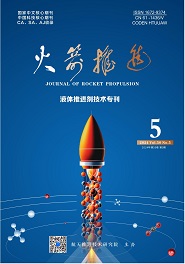航天推进技术研究院主办
CHEN Fan,NIU Xiaozhe,SHE Caiqing,et al.Experimental on combustion of space propellant useless gas and liquid[J].Journal of Rocket Propulsion,2019,45(05):90-95.
航天推进剂废气废液燃烧处理实验
- Title:
- Experimental on combustion of space propellant useless gas and liquid
- 文章编号:
- 1672-9374(2019)05-0090-06
- Keywords:
- space propellant; useless gas and liquid; combustion
- 分类号:
- V555.1
- 文献标志码:
- A
- 摘要:
- 针对航天生产试验现场有毒推进剂废气废液的无害化处理,设计了一种火箭煤油/空气燃烧处理装置,通过富燃/富氧高温燃气处理硝基类氧化剂/肼类燃料的废气废液。基于该燃烧处理装置,分别进行了燃烧器性能调试以及N2O4与甲基肼的废气与废液处理实验。实验结果表明,燃烧装置在两种基本工作模态下,燃气温度小于1 200 ℃,燃烧高效、稳定; N2O4在处理流量0~20 g/s时,排放物中NOx浓度最高为25 ppm,燃气温度小于1 200 ℃; 在甲基肼处理流量<6 g/s时,排放物中VOC浓度小于0.05 ppm,NOx浓度小于2.0 ppm,其中燃气最高温度随甲基肼流量增加不断增大,最高达1 300 ℃。该燃烧处理装置可实现对有毒航天推进剂高效、彻底的处理,废气排放符合相关标准要求。
- Abstract:
- In order to realize harmless dipose of toxic propellant useless liquid and gas in aerospace production test site, a rocket kerosene/air combustion dipose device was designed to deal with the useless gas and liquid, and experiments of nitro oxidant or hydrazine dipose by fuel-rich or oxygen-rich high-temperature gas were carried out,respectively.The experimental results show that the combustor operated efficiently and stablely under the two basic working mode, and the gas temperature is less than 1 200 ℃.And the highest concentration of NOx in the emissions is 25 ppm when the mass flow rate of N2O4 in the range of 0~20 g/s, the gas temperature is less than 1 200 ℃ at the same time.When the mass flow rate of methylhydrazine in the range of 0~6 g/s, the VOC concentration in the emissions is <0.05 ppm, and the NOx concentration is less than 2.0 ppm, the temperature of gas increases with the mass flow rate of methylhydrazine continuously, the maximum value is up to 1 300 ℃.Therefore, dipose of toxic propellant by the combustion device is efficient and complete,and exhaust emission meets relevant standards.
参考文献/References:
[1] 李亚裕.液体推进剂[M].北京: 中国宇航出版社, 2011.
[2] FORBESF S, PETER A.SPLINTER V.Liquid rocket propellants [M].[S.l.]:Elsevier Inc,2003.
[3] 曹巧玲, 毛彦杰, 王中民, 等.偏二甲基肼和四氧化二氮的毒性及其中毒的急救措施[J].职业与健康, 2011, 27(12): 1419-1420.
[4] 何息忠.航天发射场偏二甲肼废气处理技术的现状和发展趋势[J].环境保护科学, 1997, 23(4): 6-7.
[5] 童伟, 王伟清, 赵冰, 等.四氧化二氮废气吸收新方法的研究[J].化学推进剂与高分子材料, 2018, 16(3): 66-71.
[6] 郝战焱, 孙波, 朱海涛, 等.肼推进剂废气处理系统设计[J].航天器环境工程, 2016, 33(4): 451-455.
[7] 邓小胜, 刘祥萱, 刘渊, 等.偏二甲肼废水处理技术进展[J].化学推进剂与高分子材料, 2015, 13(3): 21-25, 34.
[8] 黎波, 黄智勇, 胡继元.偏二甲肼废气处理技术的研究现状与前景[J].化学推进剂与高分子材料, 2017, 15(3): 50-53.
[9] 佚名.火箭废气处理取得成果[J].航天技术与民品,1996(5):10.
[10] 何息忠.催化燃烧法处理火箭推进剂偏二甲肼废气在航天发射场的应用[J].重庆环境科学, 1996(5): 51-52.
[11] 焦天恕, 吕功暄, 张立清, 等.一种用于偏二甲肼废气无害化处理的撬装装置:CN204911233U [P].2015-12-30.
[12] 曹立仁,刘东勋,周东兴,等.处理偏二甲肼或/和四氧化二氮的燃烧炉及其应用方法:CN1786573 [P].2006-06-14.
[13] 沈全福.用煤油法处理航天发射场四氧化二氮和偏二甲肼废气[J].靶场试验与管理, 2001(2):5-8.
[14] 侯瑞琴, 刘铮, 张统.航天发射场推进剂环境污染治理技术研究[J].导弹与航天运载技术, 2011(1): 54-57.
[15] 张福光, 周红梅, 齐强, 等.废弃液体推进剂通用销毁处理设备[J].兵工自动化, 2011, 30(3): 1-2, 10.
[16] 张晖,李彬,赵杰,等.一种四氧化二氮废液的处理装置及方法:CN106765209A [P].2017-05-31.
[17] 郑显鹏,姜会敏,张丽娜.危险废物焚烧及废气治理工程实例[J].资源节约与环保,2018(9):101.
[18] 左海滨, 程志杰.烧结过程中NOx生成机理及控制技术[C]//第十四届全国炼铁原料学术会议论文集.北京:中国金属学会,2015.
[19] 国家环境保护局科技标准司.大气污染物综合排放标准:GB16297-1996[S].北京:中国标准出版社,1996.
[20] 王心超,夏亚东,朱明生.车间空气一甲基肼卫生标准:GB16222-1996 [S].北京:中国标准出版社,1996.
备注/Memo
收稿日期:2019-03-07; 修回日期:2019-05-16作者简介:陈 帆(1989—),男,硕士,研究领域为液体火箭发动机介质试验技术
